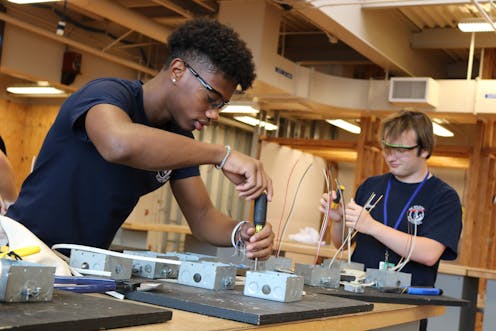For male students, technical education in high school boosts earnings after graduation
Students who get admitted to Connecticut's career and technical education high schools are more likely to graduate and earn significantly more than peers who barely missed the cut.

Job prospects for young men who only have a high school diploma are particularly bleak. They are even worse for those who have less education. When young men experience joblessness, it not only threatens their financial well-being but their overall well-being and physical health.
Could a high quality and specialized technical education in high school make a difference?
Based on a study I co-authored with 60,000 students who applied to the Connecticut Technical High School System, the answer is: yes.
To reach this conclusion, we studied two groups of similar students: Those who barely were admitted to the Connecticut Technical High School System and those who just missed getting in. Students apply to these high schools and submit things such as test scores, attendance and discipline records from middle school. Then, applicants are ranked on their score and admitted in descending order until all seats are filled. We compared those whose score helped them get the last space in a school, to those who just missed being admitted because the school was out of space.
This enabled us to determine whether there was something special about Connecticut’s Technical High School System education that gave students an advantage over peers who also applied, but didn’t get into one of the system’s 16 technical schools across the state.
Widespread appeal
Connecticut Technical High School System is a popular choice for students - about 50% more students apply than can be admitted.

The system functions such that students can apply to attend a school in the tech system instead of their assigned public school. Statewide, the system schools – which offer specialized instruction in a variety of career fields – serve about 10% of the high school students. Most students who don’t get into the tech schools stay in their public high school.
What we found is that students who were admitted to the Connecticut Technical High School System went on to earn 30% more than those who didn’t get admitted. We also found that the tech school students were 10 percentage points more likely to graduate from high school than applicants who didn’t get in – a statistically significant finding.
Our research suggests that expanding a technical high school system like the one in Connecticut would benefit more students. I make this observation as one who examines outcomes associated with career and technical education.
The track record
Career and technical education has already been shown – at least on an individual or small scale level – to positively impact earnings and high school graduation rates.
Career and technical education does this without taking away from general learning in traditional subjects like math and English. But based on my experience, it has never been clear as to whether career and technical education makes a difference on a system-wide level rather than at just one or among a few select schools.
Our recent study finally answers that question because we studied an entire state technical high school system. Specifically, it shows that, yes, career and technical education can give students the same benefits that it has already been shown to give on a smaller level even if it’s scaled up. This has implications for school districts and states, especially as growing interest in what works in career and technical education.
The appeal of technical education in Connecticut
Once admitted into the Connecticut technical high school system, all students take career and technical education coursework instead of other electives, such as world languages, art or music. Typically, coursework is grouped into one of 10 to 17 programs of study, such as information technology, health services, cosmetology, heating ventilation and air conditioning, and production processes, among others. Traditional public high schools in the state, on the other hand, tend to offer at most four career and technical programs through elective courses.
In the Technical High School System schools in Connecticut, students explore various programs of study during their first year. Then – with help from an adviser – students select a program of study. Within these programs, students take at least three aligned courses and often more. They also have more opportunity to align academic and technical coursework materials, so that math and English content can often be integrated into technical courses. Chances for work-based learning and job exposure can also be enhanced in these settings, which may contribute to their impact.
Better outcomes
To figure out if these technical schools were making a difference, we looked at admissions from 2006-2007 through 2013-2014 for 60,000 students.
We found that – compared to students who just missed being admitted – technical high school students had:
• Better 9th grade attendance rates; absenteeism rates fell by 14%
• Higher 10th grade test scores (like moving from the 50th to the 57th percentile, which is a significant jump for high school test scores)
• A greater likelihood of graduating from high school, about 85% versus 75% for those who just missed being admitted
• Higher quarterly earnings, over 30% higher
• While we found a lower likelihood of attending college initially, no differences were seen by age 23
As educators, elected officials and parents search for more effective ways to give young men in high school a better shot at being able to earn a living, our study suggests that Connecticut might have already figured it out.
[ Deep knowledge, daily. Sign up for The Conversation’s newsletter. ]
Shaun M. Dougherty receives funding from the Institute of Education Sciences, U.S. Department of Education, through Grant R305A180511 to Vanderbilt University. The study team and project are part of the CTE Research Network, which seeks to expand the evidence base on the impact of CTE programs on student outcomes. The network is supported by the Institute of Education Sciences at the U.S. Department of Education with funds provided under the Carl D. Perkins Career and Technical Education Act through Grant R305N180005. The study was conducted in cooperation with the State of Connecticut Departments of Education and Labor through the P20Win Process.
Read These Next
RFK Jr. wants to scrutinize the vaccine schedule – but its safety record is already decades long
Federal officials are questioning the safety of the vaccine series children receive. Here’s the story…
Deception and lies from the White House to justify a war in Venezuela? We’ve seen this movie before
Two US wars based on lies, in which tens of thousands of American troops and millions of civilians died,…
Miami’s new mayor faces a housing affordability crisis, city charter reform and a shrinking budget
Eileen Higgins won a hard-fought election to become Miami’s new mayor. Now for the hard part – governing…






